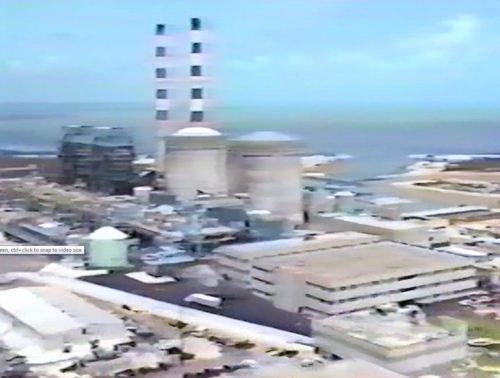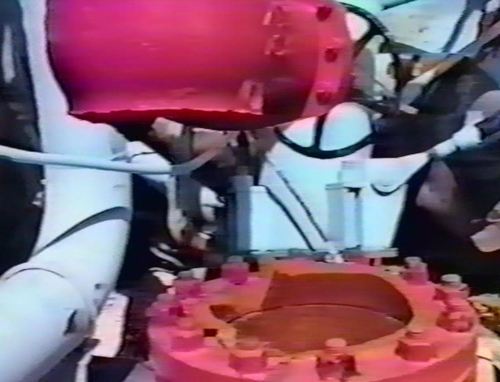
Figure 1
Hurricane Andrew hit south Florida on August 24, 1992. The eye of the hurricane, which had sustained winds of up to 145 miles per hour with gusts up to 175 miles per hour, passed directly over the Turkey Point nuclear plant site and caused extensive damage to its four generating units. Turkey Point, located about 25 miles south of Miami, had two oil-fired units and two nuclear-powered units. Figure 1 shows the two nuclear units in the right foreground with the two oil-fired units in the left background.The hurricane knocked out all offsite power for the plant for more than five days, caused the total loss of the plant’s communication systems, blocked the access road to the site with debris, and damaged the fire protection and security systems as well as the warehouse facilities. There was no damage to the safety related systems except for minor water intrusion. No radiation was released to the environment. The nuclear units, which had been manually shut down hours before the hurricane arrived, remained in a stable condition.
The telephone systems at Turkey Point did not function because the hurricane damaged the onsite antennas and the offsite repeating stations. Except for one hand-held radio, the plant’s radio systems did not function during and immediately following the storm. Overall, all offsite communications were lost for about four hours during the storm, and reliable communications were not restored for about 24 hours following the storm.
The fire protection system at the plant was disabled when winds knocked a high tower tank onto a 500,000 gallon tank containing water for the fire protection system. Figure 2 shows the blue base of the high tower tank (B) and the green walls and siding of the demolished water tank (A). Figure 3 shows the red fire protection system piping snapped in two when the high tower tank smashed the 500,000 gallon tank. The high tower tank was intended to supply water by gravity feed for fighting fires while the tank held water that diesel-driven and electric-motor-driven fire pumps could deliver for fire fighting.

Figure 2

Figure 3.
In addition, the winds severely cracked the exhaust stack on the Unit 1 oil-fired plant. Figure 4 shows a close-up of the cracked exhaust stack. If’ the damaged stack had fallen, it could have landed on the building housing the emergency diesel generators for the nuclear units. Considering that the diesel generators were the only source of ac power at the plant for several days, it was extremely fortunate that the leaning stack of Turkey Point did not fall.

Figure 4
Our Takeaway
A nuclear plant should be designed to withstand the forces of nature expected at its location. Hurricanes with winds up to 175 miles per hour occur in south Florida. A good design would not have high winds disable the fire water system and seriously challenge the backup power system. It’s just wrong to design the emergency diesel generator building to withstand high winds but construct it within falling distance of a heavy stack likely to be toppled by high winds.
“Fission Stories” is a weekly feature by Dave Lochbaum. For more information on nuclear power safety, see the nuclear safety section of UCS’s website and our interactive map, the Nuclear Power Information Tracker.
